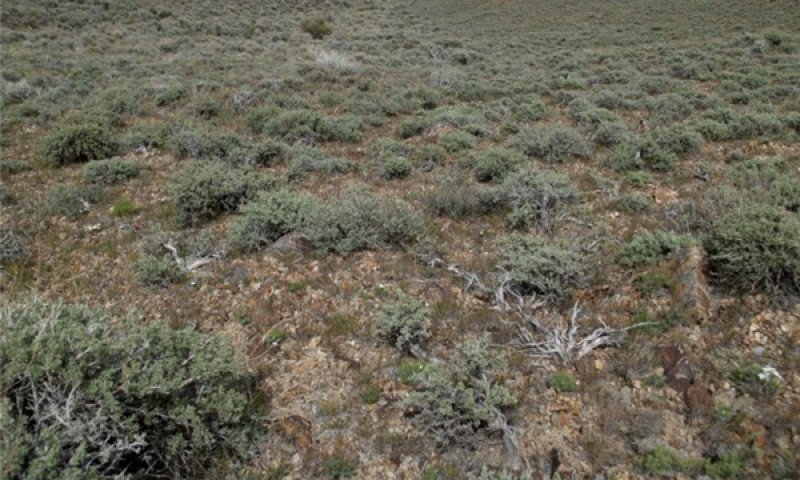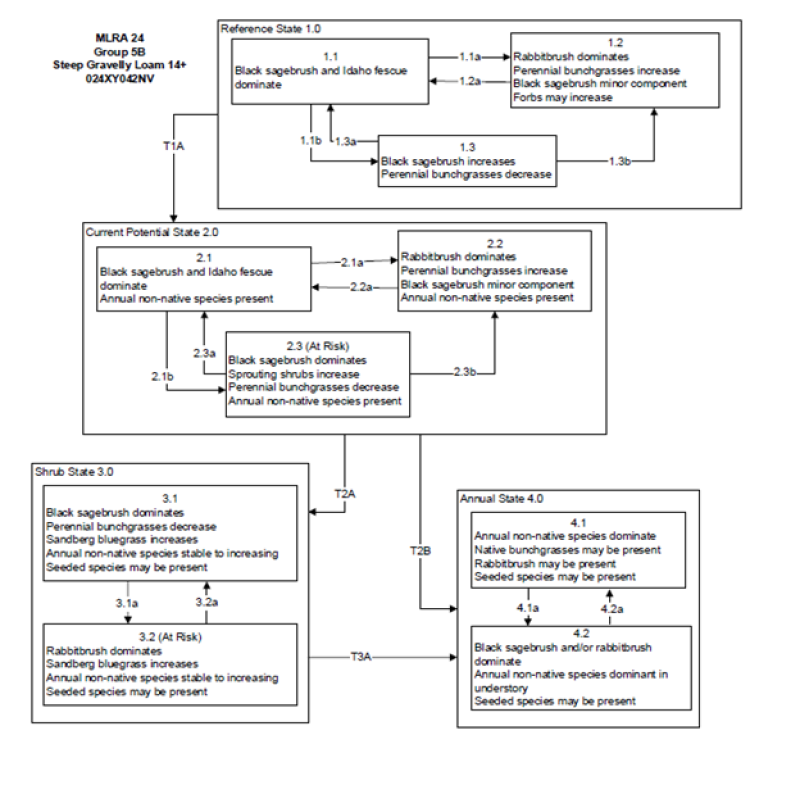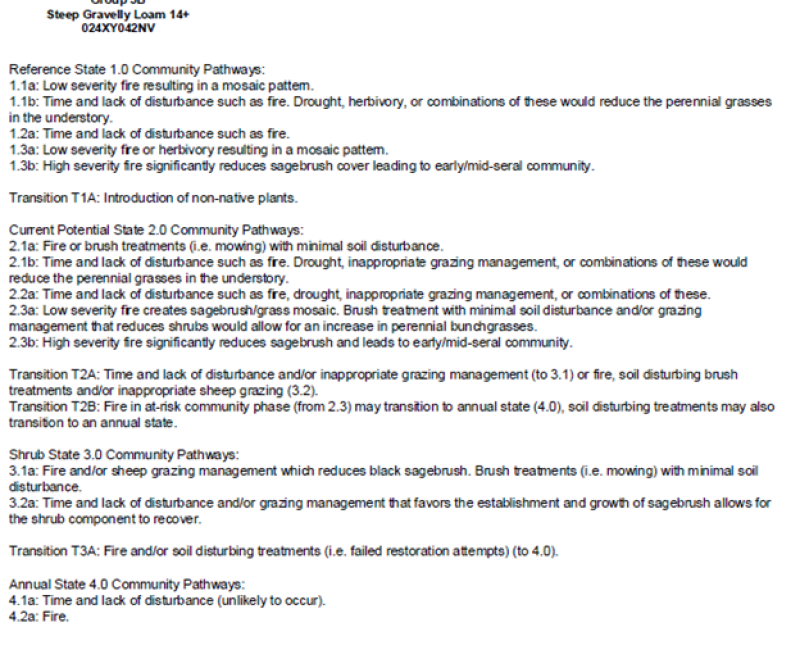Ecological dynamics
As ecological condition declines and where management results in abusive grazing use by cattle or feral horses, bluebunch wheatgrass and Idaho fescue decrease as Sandberg's bluegrass and bottlebrush squirreltail increase in the understory while black sagebrush and rabbitbrush increase and become the dominant overstory vegetation. Abusive grazing by sheep will reduce black sagebrush and greatly decrease Idaho fescue, Thurber's needlegrass and bluegrass composition in the plant community. Cheatgrass, Russian thistle, and halogeton are species most likely to invade this site.
Fire Ecology:
Black sagebrush communities generally lack enough fine fuels to carry a fire. In addition to low fine fuel loading, wide shrub spacing makes fire infrequent or difficult to prescribe in black sagebrush types. Black sagebrush is highly susceptible to fire-caused mortality; plants are readily killed by all fire intensities. Following burning, reestablishment occurs through off-site sources. Idaho fescue grows in a dense, fine-leaved tuft. Fires tend to burn within the accumulated fine leaves at the base of the plant and may produce temperatures sufficient to kill some of the root crown. Mature Idaho fescue plants are commonly reported to be severely damaged by fire in all seasons. Cusick’s bluegrass is unharmed to slightly harmed by light-severity fall fires. Cusick’s bluegrass regenerates after fire from seed and by tillering. Burning bluebunch wheatgrass may remove most of the aboveground biomass but does not usually result in plant mortality. Bluebunch wheatgrass is generally favored by burning. Burning stimulates flowering and seed production. However, season of burning affects mortality.
State 1
Reference State
The Reference State is a representative of the natural range of variability under pristine conditions. The Reference State has three general community phases; a shrub-grass dominant phase, a shrub dominant phase and a grass dominate phase. State dynamics are maintained by interactions between climatic patterns and disturbance regimes. Negative feedbacks enhance ecosystem resilience and contribute to the stability of the state. These include the presence of all structural and functional groups, low fine fuel loads, and retention of organic matter and nutrients. Plant community phase changes are primarily driven by fire, periodic drought and/or insect or disease attack. Due to the nature and extent of disturbance in this site, all three plant community phases would likely occur in a mosaic across the landscape.
Community 1.1
Reference Plant Community
The reference plant community is dominated by black sagebrush, Idaho fescue, and Cusick's bluegrass.
Potential vegetative composition is about 60% grasses, 10% forbs and 30% shrubs.
Approximate ground cover (basal and crown) is 30 to 40 percent.
Table 5. Annual production by plant type
| Plant type |
Low
(lb/acre) |
Representative value
(lb/acre) |
High
(lb/acre) |
| Grass/Grasslike |
300 |
480 |
600 |
| Shrub/Vine |
150 |
240 |
300 |
| Forb |
50 |
80 |
100 |
| Total |
500 |
800 |
1000 |
Community 1.2
Reference Plant Community 1.2
This community phase is characteristic of a post-disturbance, early seral community phase. Thurber’s needlegrass, Indian ricegrass and other perennial bunchgrasses dominate. Sprouting shrubs such as Douglas’ rabbitbrush, spiny hopsage, and shadscale may increase. Black sagebrush could still be present in unburned patches. Forbs may increase post-fire but will likely return to pre-burn levels within a few years. Sandberg bluegrass will generally increase following fire, but may decrease in below-average years of precipitation. Sandberg bluegrass may also increase.
Community 1.3
Reference Plant Community 1.3
Black sagebrush increases in the absence of disturbance. Decadent sagebrush dominates the overstory and the deep-rooted perennial bunchgrasses in the understory are reduced either from competition with shrubs and/or herbivory. Sandberg bluegrass may increase in the understory and become the dominant grass on the site.
Pathway 1.1a
Community 1.1 to 1.2
Low severity fire resulting in a mosaic pattern.
Pathway 1.1b
Community 1.1 to 1.3
Time and lack of disturbance such as fire. Drought, herbivory, or combinations of these would reduce the perennial grasses in the understory.
Pathway 1.2a
Community 1.2 to 1.1
Time and lack of disturbance such as fire.
Pathway 1.3a
Community 1.3 to 1.1
Low severity fire or herbivory resulting in a mosaic pattern.
Pathway 1.3b
Community 1.3 to 1.2
High severity fire significantly reduces sagebrush cover leading to early/mid-seral community.
State 2
Current Potential State
This state is similar to the Reference State 1.0 and has three similar community phases. Ecological function has not changed in this state, but the resiliency of the state has been reduced by the presence of invasive weeds. These non-native species can be highly flammable, and promote fire where historically fire had been infrequent. Negative feedbacks enhance ecosystem resilience and contribute to the stability of the state. These include the presence of all structural and functional groups, low fine fuel loads and retention of organic matter and nutrients. Positive feedbacks decrease ecosystem resilience and stability of the state. These include the non-natives high seed output, persistent seed bank, rapid growth rate, ability to cross pollinate and adaptations for seed dispersal.
Community 2.1
Plant Community 2.1

Figure 4. Steep Gravelly Loam 14 phase 2.1 T. Stringham June 2010
This community phase is compositionally similar to the Reference State Community Phase 1.1 with the presence of non-native species in trace amounts. This community is dominated by black sagebrush in the overstory with Thurber’s needlegrass, Indian ricegrass dominant in the understory.
Community 2.2
Plant Community 2.2
This community phase is characteristic of a post-disturbance, early seral community where annual non-native species are present. Sagebrush is present in trace amounts; perennial bunchgrasses dominate the site. Depending on fire severity patches of intact sagebrush may remain. Rabbitbrush or other sprouting shrubs may be increasing. Annual non-native species are stable or increasing within the community.
Sandberg bluegrass will generally increase following fire, but may decrease in below-average years of precipitation. Annual non-native species generally respond well after fire and may be stable or increasing within the community.
Community 2.3
Plant Community (At-Risk) 2.3
Black sagebrush dominates the overstory and perennial bunchgrasses in the understory are reduced, either from competition with shrubs or from inappropriate grazing, or from both. Rabbitbrush may be a significant component. Sandberg bluegrass may increase and become co-dominant with deep rooted bunchgrasses. Annual non-native species may be stable or increasing due to lack of competition with perennial bunchgrasses. This site is susceptible to further degradation from grazing, drought, and fire. This community is at risk of crossing a threshold to either Shrub State 3.0 (grazing or fire) or Annual State 4.0 (fire).
Pathway 2.1b
Community 2.1 to 2.2
Time and lack of disturbance such as fire. Drought, inappropriate grazing management, or combinations of these would reduce the perennial grasses in the understory.
Pathway 2.1a
Community 2.1 to 2.3
Fire or brush treatments (i.e. mowing) with minimal soil disturbance.
Pathway 2.2a
Community 2.2 to 2.1
Time and lack of disturbance such as fire, drought, inappropriate grazing management, or combinations of these.
Pathway 2.3a
Community 2.3 to 2.1
Low severity fire creates sagebrush/grass mosaic. Brush treatment with minimal soil disturbance and/or grazing management that reduces shrubs would allow for an increase in perennial bunchgrasses.
Pathway 2.3b
Community 2.3 to 2.2
High severity fire significantly reduces sagebrush and leads to early/mid-seral community.
State 3
Shrub State
This state has two community phases, one that is characterized by a black sagebrush overstory and the other with a shadscale or rabbitbrush overstory with a Sandberg bluegrass understory. The site has crossed a biotic threshold and site processes are being controlled by shrubs. Bare ground has increased and pedestalling of grasses may be excessive.
Community 3.1
Plant Community 3.1
Black sagebrush dominates overstory while Sandberg bluegrass dominates the understory. Deep-rooted perennial bunchgrasses have significantly declined. Annual non-native species may be present. Bare ground and soil redistribution may be increasing. If present on the site, Utah juniper is increasing. The community phase may be at risk of transitioning into an Annual State.
Community 3.2
Plant Community (At-Risk) 3.2
Shadscale and/or rabbitbrush dominate the overstory. Broom snakeweed may be present to increasing. Annual non-native species may be increasing and bare ground is significant. This site is at risk for an increase in invasive annual weeds.
Pathway 3.1a
Community 3.1 to 3.2
Fire and/or sheep grazing management which reduces black sagebrush. Brush treatments (i.e. mowing) with minimal soil disturbance.
Pathway 3.2a
Community 3.2 to 3.1
Time and lack of disturbance and/or grazing management that favors the establishment and growth of sagebrush allows for the shrub component to recover.
State 4
Annual State
This state has two community phases; one dominated by annual non-native species and the other is a shrub dominated site. This state is characterized by the dominance of annual non-native species such as cheatgrass and tansy mustard in the understory. Sagebrush and/or rabbitbrush may dominate the overstory. Annual non-native species and squirreltail dominate the understory.
Community 4.1
Plant Community 4.1
Annual non-native plants such as cheatgrass or tansy mustard dominate the site. This phase may have seeded species present if resulting from a failed seeding attempt.
Community 4.2
Plant Community 4.2
Wyoming big sagebrush remains in the overstory with annual non-native species, likely cheatgrass, dominating the understory. Trace amounts of desirable bunchgrasses may be present.
Pathway 4.1a
Community 4.1 to 4.2
Time and lack of disturbance (unlikely to occur).
Pathway 4.2a
Community 4.2 to 4.1
Fire.
Transition T1A
State 1 to 2
Introduction of non-native plants.
Transition T2A
State 2 to 3
Time and lack of disturbance and/or inappropriate grazing management (to 3.1) or fire, soil disturbing brush treatments and/or inappropriate sheep grazing (3.2).
Transition T2B
State 2 to 4
Fire in at-risk community phase (from 2.3) may transition to annual state (4.0), soil disturbing treatments may also transition to an annual state.
Transition T3A
State 3 to 4
Fire and/or soil disturbing treatments (i.e. failed restoration attempts) (to 4.0).




